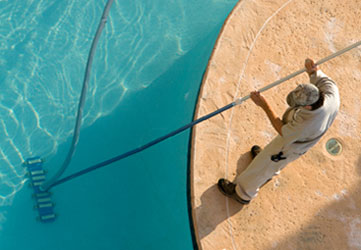LA COUNTY SWIMMING POOL TECHNICIAN PROGRAM
The certification procedure is as follows:
- Send in the application along with the appropriate fee
- Once an application is received and approved, a study guide will be sent to you.
When you feel you are ready to take the exam, call our office at (626) 430-5360 to set
up an appointment to take the exam.
- The examination is normally administered once a month, always on a Thursday, at our
Administrative Headquarters in Baldwin Park, California. The exam lasts 2 hours,
please check in at 8:45 AM to register. You should bring a No. 2 pencil and calculator.
Please leave your cell phones in your car or truck. The examination consists of 100
multiple choice questions and 65% is a passing grade.
- Once you pass the examination you will be issued a certificate and wallet card. Each year when you renew your certification you will be issued a new wallet card. Examination fees are non-refundable and must be taken within one year after payment of the fee. If you do not pass the exam, you must wait at least 30 days before retaking the exam. There is a new examination fee each time the test is taken. On the examination the applicant will be tested for knowledge on the following:
California Code of Regulations, Titles 22 & 24 regarding requirements at public pools, including:
- Disinfection, pH and stabilizer levels
- Safety signs and equipment
- Requirement of operational records
- Lifeguard requirements
- Clarity, bacteriological and chemical quality of pool water
- General requirements for maintaining pools clean, sanitary and in good repair
- Skimmers and their proper operation and maintenance
- Required turnover rates
- Replacement of equipment
- Backflow protection
- Lighting
- Depth marker requirements
- Pressure gauges
- Flow meters
- Maximum water temperatures
Understanding of the terms and concepts of the following:
- Breakpoint chlorination
- Chlorine and bromine based products used to disinfect pool water
- Methods of action of disinfectants in clarifying and sanitizing pool water
- Advantages and disadvantages of various disinfectants, their properties and effects on
pool water
- Chlorine demand. Combined, total, and free available chlorine
- Alternate methods of disinfection and treatment of pool water
- Balance of pool water. Total alkalinity, calcium hardness and pH, and proper levels in
pool water
- Other chemicals used in pool maintenance including stabilizers, sequesterants, algicides,
and flocculants
- Effects of corrosive and alkaline water
- Tests and proper use of test kits for measuring disinfectant residuals, pH and other
chemical levels in pool water
- Detrimental effects on health of improperly disinfected and balanced pool water
- Pool chemical safety
- Pool filter types, capabilities, sizing, cleaning and maintenance
- Pool pumps, basic design, operation, characteristics, and maintenance. Pump curves
- Chemical feeders, their proper sizing, use, and maintenance
- Supplemental equipment associated with pool recirculation systems including, separation
tanks, multiport valves, hydrostatic valves, sizing of pool heaters, and ORP meters
How to:
- Calculate pool and spa volumes
- Elevate or lower pH, alkalinity, calcium and stabilizer levels
- Calculate levels of disinfectant in part per million given a pool volume and amount of disinfectant added
- Calculate minimum flow rates, turnover rates, and filter sizes for public pools
- Determine total dynamic head of a pool recirculation system
- Determine the flow rate from total dynamic head and pump curve charts
- Calculate volume of water loss through leakage and evaporation
- Calculate saturation index
- Calculate horsepower given, watts, voltage, and amperage







